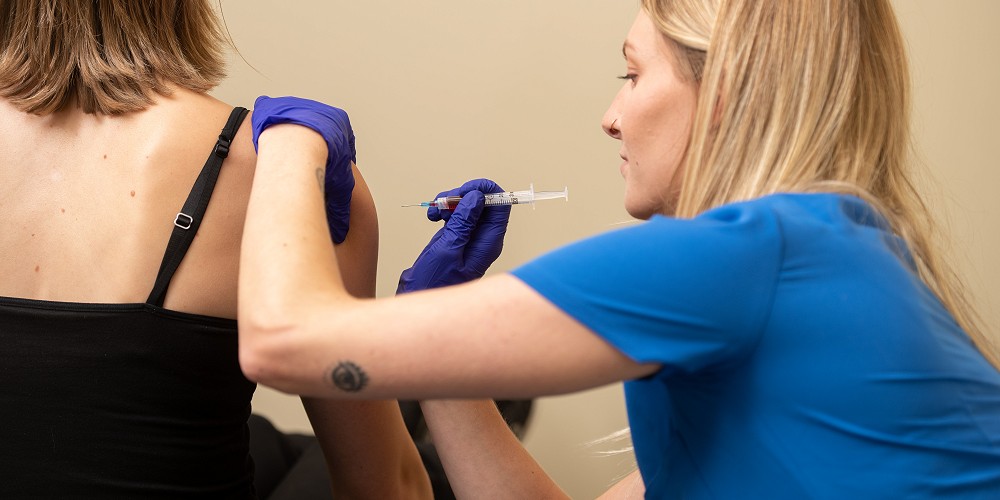Physiotherapy After Breast Cancer
Article by Danielle Roberts
Physiotherapists have an important role to play in the recovery process for patients who have had treatment for breast cancer.

Physiotherapists are trained to help with symptom management, to prevent future side effects, and to assist you in returning to your day-to-day life.
After breast cancer surgery, radiation therapy, and/or chemotherapy, there are complications that can occur, which a trained physiotherapist can help you to avoid.
How Physiotherapists Can Help Post-Surgery
Here are the top aims of Physiotherapy Treatment:
- Immediately after surgery, a high priority of treatment is to maximize healing of incision site(s) and lymphatic vessels. Interventions may include education on wound healing and post-operative restrictions, gentle mobility exercises, and light activation exercises for the affected arm [Harris et al, 2012].
- Early rehabilitation will focus on regaining full shoulder range of motion, strength, and functional abilities. Treatment will likely consist of mobility exercises, stretching, and progressive resistance exercises [Harris et al, 2012]. Gentle manual therapy techniques may also be used in conjunction with therapeutic exercise.
- Late rehabilitation could include restoring/optimizing posture along with providing education on return to functional activities and work. Your physiotherapist may prescribe you an ongoing home exercise program - identifying key structures that may need additional strengthening or stretching post-operatively, along with guidance on modifications that can be made for a safe return to work and everyday activity.
Prevention is Key
Prevention of adverse side effects is of utmost importance during physiotherapy treatment. Complications to be aware of include:
- Adhesive capsulitis (frozen shoulder) - a painful immobility or stiffness within the shoulder joint that can result in a global loss of shoulder function. Prevention of this condition generally includes early range of motion exercises.
- Axillary cording (axillary web syndrome) - the development of cord-like tissues in the underarm as a result of lymph node dissection from the axilla. The cords are thought to be scarring of the lymphatic tissues to the surrounding tissues, which can cause restrictions in shoulder movement. Treatment of this condition generally includes manual therapy to reduce the adhesions along with gentle mobility exercises [Kepics, 2004].
- Neural tethering - a condition in which the peripheral nerves have reduced mobility due to scarring post-operatively, resulting in pain, numbness, and/or tingling of the upper extremity. Early mobilization and scar tissue massage can help prevent adhesions of these tissues [Kepics, 2004].
- Lymphedema - swelling of the tissues after damage or obstruction of lymph vessels and nodes after surgery for breast cancer. Lymphedema may occur in the breast, trunk, or arm of the affected side. Exercise has been found to help prevent occurrence, but early management can also help to reverse the effects [Rankin et al, 2008]. Compression sleeves, manual lymph drainage massage, and education may be used for treatment of this condition [Harris et al, 2012].
Accessing Physiotherapy Services for Rehabilitation After Breast Cancer Treatment
Accessing physiotherapy services for rehabilitation after breast cancer treatment has been found to reduce the likelihood of losing shoulder mobility, improve self-management, and alleviate distressing symptoms of treatment [Harris, 2012].
As well, exercise has been found to improve both physical and mental health of breast cancer survivors [Harris, 2012], along with preventing and reducing disability [Rankin et al, 2008].
By working together with a physiotherapist, you can address your individual goals and needs to best improve your quality of life and reduce future health complications.
References
- Harris, S. R., Schmitz, K. H., Campbell, K. L., McNeely, M. L. (2012) Clinical practice guidelines for breast cancer rehabilitation: Synthesis of guideline recommendations and qualitative appraisals. Cancer, 118 (8), 2312-2324.
- Kepics, J. (2004) Physical therapy treatment of axillary web syndrome. Rehabilitation Oncology, 22 (1), 21-22.
- Rankin, J., Robb, K., Murtagh, N., Cooper, J., Lewis, S. (2008) Rehabilitation in Cancer Care. Chichester, United Kingdom: Wiley Blackman
You May Also Like...
-
 ArticleView Post
ArticleView PostTrigger Point Injections for TMD: A Targeted Approach to Jaw Pain
Jaw pain can be frustratingly persistent. In certain cases, trigger point injections can be a very effective treatment.
-
 ArticleView Post
ArticleView PostInjectable Therapy (Part 1 of 2): Prolotherapy, PRP, and Cortisone
Nearly 8 million Canadian residents are living with the diagnosis of chronic pain1. Living with pain can impact one’s abilities to participate in activities of daily living—such as work, school, and socialization. There are many possible branches of treatment for chronic pain, and this article highlights the positive role that injectable therapies can have.
-
 ArticleView Post
ArticleView PostA Pain in the Butt, or a Pain in the Back?
Could your leg pain actually be coming from your back? Let’s take a look at pain originating from the sciatic nerve, the largest nerve in your body.